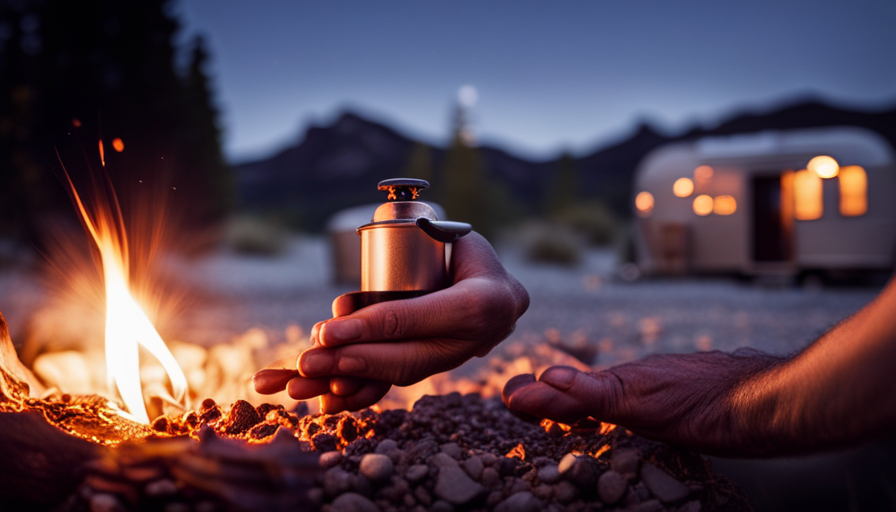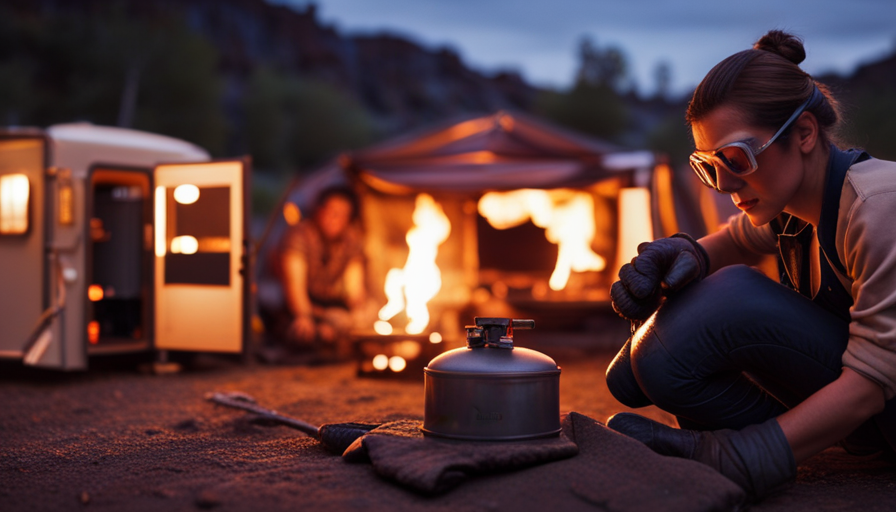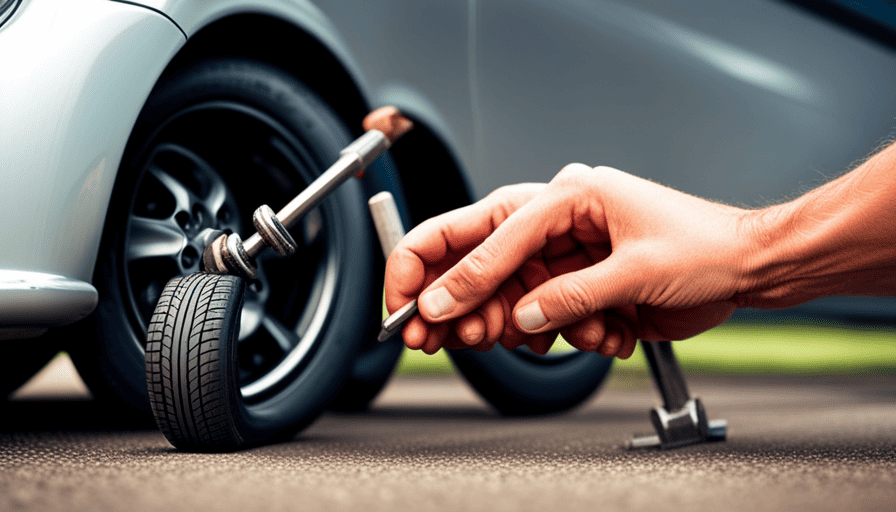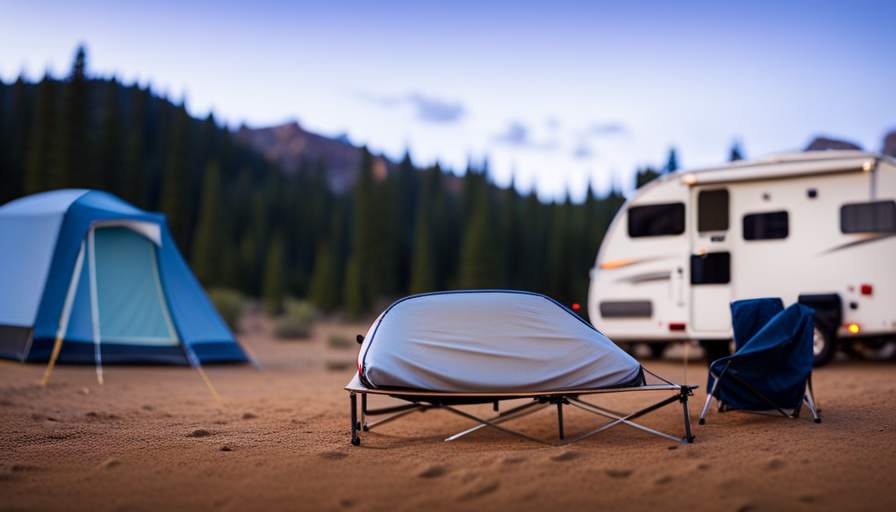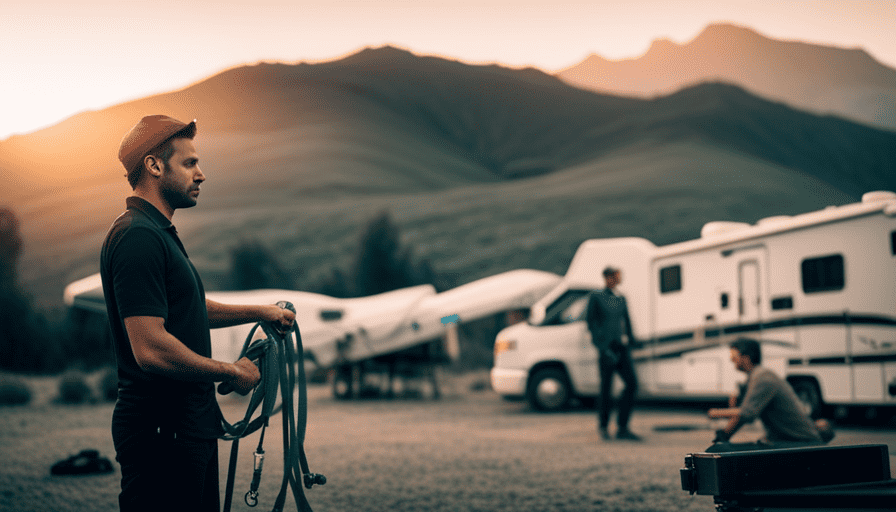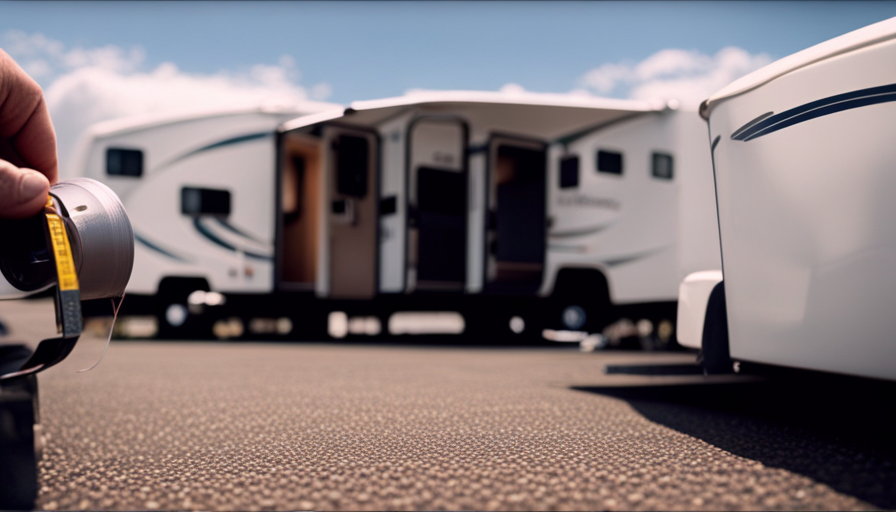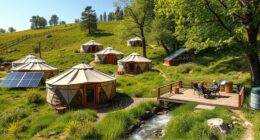Are you ready to enjoy a comforting shower after a long day outdoors? Get ready to be impressed as I share the ultimate guide on how to ignite a camper’s hot water heater. Trust me, this tip will completely enhance your camping experience and take it to a whole new level of enjoyment.
Now, you might be thinking, ‘How difficult can it be?’ Let me tell you, it’s not as simple as just flipping a switch. But fear not, my fellow campers, because I’m here to guide you through the process step by step. From gathering the necessary supplies to testing the hot water, I’ll leave no stone unturned.
So, grab your pen and paper, get ready to take notes, and let’s dive into the world of camper hot water heaters!
Key Takeaways
- Gathering necessary supplies before attempting to light the heater is important.
- Checking gas supply: use gas leak detector, inspect gas valves/connections, check propane tank, ensure gas supply valve is turned on, troubleshoot common issues.
- Understanding different parts of water heater (gas valve, pilot light, burner, thermostat, pressure relief valve, anode rod) is important for maintenance and troubleshooting.
- Follow safety precautions, ensure area is clear of flammable materials.
Gather the Necessary Supplies
Now, let’s get started by gathering all the supplies you’ll need to light your camper hot water heater. Before we begin, it’s important to note some common mistakes to avoid when lighting a camper hot water heater. First, make sure you read the manufacturer’s instructions thoroughly to understand the specific requirements for your heater model. Additionally, always double-check that the gas supply is turned off before attempting to light the pilot.
Now, back to the supplies you’ll need. Firstly, you’ll need a long-reach lighter or matches specifically designed for lighting gas appliances. These ensure safe ignition without the risk of getting burned. Secondly, make sure you have a flashlight handy to help you see in dimly lit areas. It’s also a good idea to have a small brush or soft cloth for cleaning any debris or dust that may have accumulated around the pilot light area.
Lastly, don’t forget to gather some tips for maintaining a camper hot water heater, which we’ll discuss in the next section.
With all your supplies ready, let’s move on to checking the gas supply.
Check the Gas Supply
First, make sure the gas supply is properly checked before proceeding with the next steps. It’s crucial to check for any leaks or issues that may affect the operation of the camper hot water heater. Here are five important things to keep in mind:
-
Use a gas leak detector to check for any gas leaks around the water heater. This’ll help ensure your safety and prevent any potential accidents.
-
Inspect the gas valves and connections for any signs of damage or wear. Tighten any loose connections and replace any faulty parts if necessary.
-
Check the propane tank to make sure it’s properly filled. If the tank is low on propane, it may not provide enough gas pressure for the water heater to function efficiently.
-
Make sure the gas supply valve is turned on. Sometimes, it may accidentally get turned off, causing the water heater to not function properly.
-
Troubleshoot common issues such as a pilot light that won’t stay lit or a burner that won’t ignite. Refer to the manufacturer’s instructions or seek professional assistance if needed.
Once the gas supply is confirmed to be in good condition, you can proceed to the next step of locating the water heater.
Locate the Water Heater
To find the water heater, you’ll want to start by carefully inspecting the surrounding area for any visible signs or indicators. Look for a metal box or compartment that is typically located on the outside of the camper. It may be labeled as the water heater or have a specific logo or symbol indicating its purpose. Once you have located the water heater, it’s important to familiarize yourself with its components and layout. To assist you in this process, I have created a table below that outlines the main parts of a typical camper water heater.
| Component | Description |
|---|---|
| Gas Valve | Controls the flow of gas to the burner |
| Pilot Light | Small flame that ignites the burner |
| Burner | Heats the water in the tank |
| Thermostat | Regulates the temperature of the water |
| Pressure Relief Valve | Releases excess pressure from the tank |
| Anode Rod | Protects the tank from corrosion |
Understanding the different parts of the water heater is essential for proper water heater maintenance and troubleshooting common water heater issues. Now that we have located the water heater, let’s move on to the next step of turning off the gas valve.
The subsequent section will detail how to turn off the gas valve effectively.
Turn Off the Gas Valve
As you approach the small metal box tucked away in the corner, imagine the quiet hiss of escaping gas, a reminder of the potential danger that lies within. Before attempting to light a camper hot water heater, it’s crucial to ensure the gas valve is turned off. This step is vital for safety reasons and prevents any accidents or gas leaks. To turn off the gas valve, locate it on the side of the water heater. It’s typically a small lever or knob that can be turned horizontally to shut off the gas supply.
Once the gas valve is turned off, you can proceed with troubleshooting the pilot light. This involves checking if the pilot light is lit and if not, following the manufacturer’s instructions to relight it. Remember to exercise caution and follow all safety precautions while dealing with gas-related components.
Now that the gas valve is turned off and the pilot light has been addressed, the next step is to remove the access panel.
- A sense of urgency fills the air as you take this crucial safety measure.
- The potential danger of a gas leak is ever-present, emphasizing the importance of turning off the gas valve.
- Your heart races as you troubleshoot the pilot light, ensuring that it’s properly functioning.
- The detailed instructions provided by the manufacturer guide you through this technical process.
With the gas valve turned off and the pilot light troubleshot, it’s time to move on to the next step: removing the access panel.
Remove the Access Panel
Now that the gas valve is turned off and the pilot light has been addressed, it’s time to delve deeper into the process by removing the access panel. This step is crucial in order to gain access to the inner components of the camper hot water heater. Before proceeding, it is important to take some safety precautions to ensure a smooth and secure operation. Common issues that may arise during this step include rusty screws or difficult-to-remove panels. To tackle these issues, it is recommended to use a rust penetrant spray and a sturdy screwdriver or wrench.
To remove the access panel, follow these steps:
| Step | Action |
|---|---|
| 1 | Shut off the power supply to the water heater. |
| 2 | Locate the screws that secure the access panel in place. |
| 3 | Apply a rust penetrant spray to any rusty screws. |
| 4 | Use a screwdriver or wrench to loosen and remove the screws. |
Once the access panel is successfully removed, you can proceed to the next step of finding the pilot light. This will allow you to continue with the process of lighting the camper hot water heater.
Find the Pilot Light
Once you’ve successfully removed the access panel, you’ll be amazed at how elusive the pilot flame can be. Finding the pilot light is crucial when troubleshooting a camper hot water heater.
To begin, locate the gas control valve, which is usually situated near the bottom of the heater. Look for a small, round knob labeled ‘Pilot’ or ‘Pilot Light.’ Once you’ve identified the knob, turn it to the ‘Off’ position and wait for a few minutes to allow any residual gas to dissipate.
Afterward, turn the knob to the ‘Pilot’ position and press it down, holding it in place. This will allow gas to flow to the pilot light. While keeping the knob depressed, use a long match or lighter to ignite the pilot light. Once the flame is lit, continue holding the knob for about a minute to ensure the pilot light stays lit. If it doesn’t, repeat the process.
Remember, regular maintenance is key to keeping your camper hot water heater in good working order.
Now that you’ve found the pilot light, let’s move on to lighting it.
Light the Pilot Light
To get the pilot flame going, it’s time to spark up that little fire in your camper’s trusty water heater. Here’s how to ignite the pilot flame and troubleshoot any pilot light issues:
First, locate the pilot light assembly. It’s usually located near the bottom of the water heater, behind a removable panel.
Turn the gas control knob to the ‘off’ position. Wait for a few minutes to allow any residual gas to dissipate.
Now, turn the gas control knob to the ‘pilot’ position and press it down. This will allow gas to flow to the pilot assembly.
While holding the knob down, use a long-reach lighter or match to ignite the pilot flame. Place the flame near the pilot burner and you should see the flame ignite.
If the pilot flame doesn’t ignite, it could be due to a clogged pilot orifice or a faulty thermocouple. In such cases, it’s recommended to call a professional for assistance.
Once the pilot flame is lit, continue to hold the pilot button down for about 30 seconds to allow the thermocouple to heat up.
This will enable the thermocouple to sense the presence of the pilot flame and keep the gas valve open.
Now, you’re ready to move on to the next step of holding the pilot button and turning the gas control knob to the ‘on’ position.
To hold the pilot button and proceed to the next step, follow the instructions in the subsequent section.
Hold the Pilot Button
Take a moment to firmly press and hold the pilot button as you prepare to move forward in the process of igniting the flame. This is a crucial step in lighting a camper hot water heater and requires a specific holding technique.
Start by locating the pilot button, which is usually red and located near the control panel. Once you’ve found it, firmly press down on the button and hold it in place. While holding the pilot button, you’ll need to simultaneously press the igniter button to create a spark that’ll ignite the pilot light. Keep holding the pilot button for about 30 seconds to ensure the flame stays lit.
As you hold the pilot button, it’s important to follow some safety precautions. Make sure the area surrounding the water heater is clear of any flammable materials or debris. Keep a close eye on the pilot light to ensure it remains lit during this process, as a weak or extinguished flame could indicate a problem. If the flame goes out, wait a few minutes before attempting to relight it.
Once you’ve successfully held the pilot button and the flame is lit, you can proceed to replace the access panel. This will protect the pilot light and prevent any accidental damage.
Replace the Access Panel
After successfully holding down the pilot button to ignite the camper hot water heater, the next step is to replace the access panel. This crucial step ensures that the inner workings of the heater are protected and secured.
To do this, follow these simple instructions.
First, locate the access panel on the front of the water heater. It’s usually held in place by screws or clips. Carefully remove these screws or release the clips to open the panel. Be cautious not to damage any wires or components inside.
Once the access panel is off, inspect the ignition system for any signs of damage or wear. If you notice any issues, such as loose wires or corroded parts, it may be necessary to troubleshoot the ignition problem before replacing the panel.
To replace the access panel, align it with the designated slots or holes on the heater and secure it back in place using the screws or clips. Make sure it’s tightly fitted to prevent any gaps or leaks.
With the access panel securely replaced, we can now move on to the next step: testing the hot water.
Test the Hot Water
Now, you’re ready to see if your efforts have paid off and enjoy a warm, soothing shower. To test the hot water in your camper, follow these steps to ensure everything is functioning properly.
First, turn on the hot water faucet in your camper. Make sure it’s fully open to allow water to flow freely. Pay close attention to the pressure of the hot water. It should be strong and consistent. If you notice any weak pressure or fluctuation, you may need to troubleshoot hot water issues.
Next, check the temperature of the hot water. It should be hot enough to meet your comfort level. If the water isn’t hot enough, you may need to adjust the temperature settings on your hot water heater.
Additionally, keep an eye out for any unusual noises or smells coming from the hot water system. These could be signs of a problem that needs further investigation.
Test the hot water for an extended period of time to ensure it remains consistent and reliable. Take note of any changes or issues that arise during this test.
By following these steps, you can effectively test the hot water pressure and troubleshoot any hot water issues in your camper. Enjoy your warm and refreshing showers!
Frequently Asked Questions
How long should I hold the pilot button before lighting the pilot light?
Before lighting the pilot light, I recommend holding the pilot button for at least 30 seconds, or until you can smell the gas. It’s crucial to ensure the proper ignition of the pilot light, as it’s responsible for heating the water in your camper. Holding the button for a sufficient amount of time allows the gas to flow steadily, increasing the chances of a successful ignition. Remember to follow all safety precautions while doing this procedure.
Can I use a different type of fuel besides gas for my camper hot water heater?
Using alternative fuel options for your camper hot water heater can be risky. While it’s possible to use fuels like diesel or propane, it’s important to consider the pros and cons. Diesel may be more efficient, but it can be harder to find and may require modifications to your heater. Propane is more readily available, but it can be expensive and may require additional equipment. Always consult the manufacturer’s guidelines before attempting to use alternative fuels.
What should I do if I can’t locate the pilot light on my camper hot water heater?
If you can’t locate the pilot light on your camper hot water heater, don’t panic. Stay calm and follow these troubleshooting steps.
First, check for any obstructions or debris in the pilot light area. If everything looks clear, you can try using alternate ignition methods such as an electric igniter or a matchstick.
Make sure to refer to your hot water heater’s manual for specific instructions on how to use these methods safely.
How often should I check the gas supply for my camper hot water heater?
I regularly check the gas supply for my camper hot water heater to ensure it’s functioning properly. To do this, I first check the gas pressure using a pressure gauge. If the pressure is low, I troubleshoot common pilot light issues such as a clogged or dirty pilot tube, a faulty thermocouple, or a gas valve problem. Regularly checking the gas supply helps prevent any potential issues and ensures a reliable hot water heater.
Is it safe to leave the access panel open while testing the hot water after lighting the pilot light?
No, it’s not necessary to close the access panel while testing the hot water after lighting the pilot light. Leaving the access panel open while testing the hot water after lighting the pilot light won’t cause any issues. However, it’s important to exercise caution and follow all safety guidelines when working with a camper hot water heater. Always refer to the manufacturer’s instructions for specific details on operating and maintaining your particular model.
Can the Same Method Be Used to Light the Pilot Light on Different Types of Camper Water Heaters?
When it comes to lighting the pilot light on different types of camper water heaters, the same method might not always work. Each heater may have its own unique process, so it’s important to consult the manufacturer’s instructions. Properly following the steps specific to your lighting pilot light camper water heater is crucial for a successful ignition.
Conclusion
So there you have it, folks! Lighting a camper hot water heater may seem like a daunting task, but it’s actually quite simple with the right supplies and a little know-how. Just remember to check the gas supply and locate the water heater, then turn off the gas valve before proceeding.
Next, remove the access panel and light the pilot light. Hold the pilot button until the flame is steady.
Finally, replace the access panel and test the hot water. With these steps, you’ll be enjoying hot showers on your camping trips in no time!

